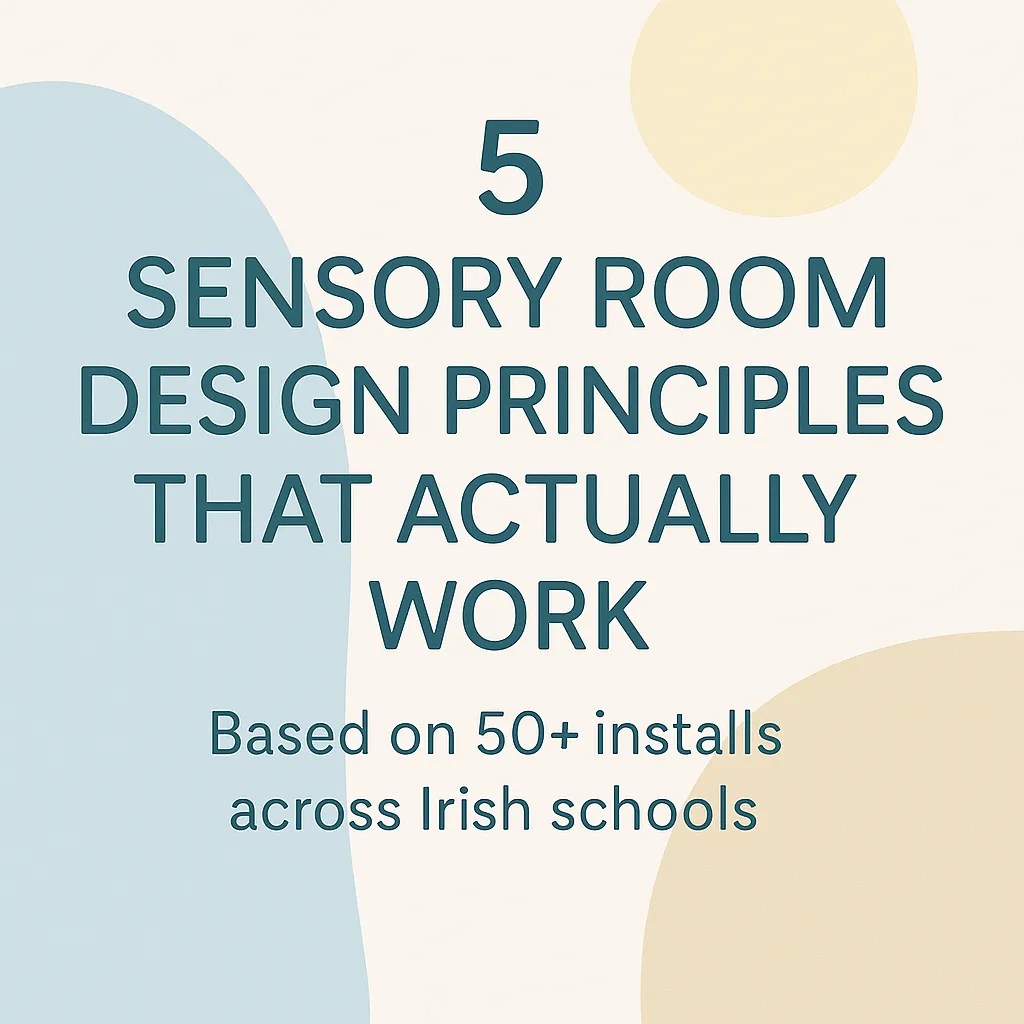
🧠 5 Sensory Room Design Principles That Actually Change Lives
How to Design Spaces That Regulate, Restore, and Empower Neurodivergent Learners
A sensory room isn’t a trend. It’s a tool for transformation — when it’s designed right.
At Sensory Sphere, we’ve worked hands-on with over 50 Irish schools to turn underused corners and blank rooms into life-changing environments for autistic, ADHD, and sensory-sensitive students.
But too often, we’re called in to fix rooms that were built with good intentions… and poor design.
Here’s what makes the difference between a sensory room that looks good in photos — and one that genuinely helps children self-regulate, feel safe, and flourish.
1. 🧭 Zoning the Space for Function, Not Aesthetics
Great sensory rooms are zoned with purpose, not cluttered with good ideas.
Every square metre should invite a different type of regulation:
ZonePurposeExample ToolsCalming ZoneReduce stimulationBubble tube, beanbag, canopy curtainMovement ZoneBurn energy safelyRocker board, peanut ball, swingTactile ZoneExplore texture and focusSensory wall panels, fidgets
Even in a 9m² space, strategic zoning allows for multiple needs to be met simultaneously — whether it’s emotional regulation, sensory seeking, or a quiet decompression break.
📌 Pro tip: Use floor padding colors or visual markers to subtly divide zones without walls.
2. 💡 Light Shapes Emotion (So Choose It Like a Designer)
Lighting isn’t decoration. It’s regulation.
The wrong lighting (fluorescent, overhead, harsh white) can trigger overstimulation, migraines, or emotional shutdown — especially for autistic students.
Smart sensory rooms use:
Bubble tubes and fibre optics to provide gentle focus
Dimmable LED strips to shift energy levels
Curtains or blackout blinds to block glare
And always: warm white > cold white.
Light should never feel like punishment.
3. 🧹 Minimalism Isn’t Boring — It’s Trauma-Informed
We’ve seen it all: rooms overloaded with colours, bins of cheap toys, and no logic to the layout.
That doesn’t serve the child. It serves the adult who’s decorating.
A well-designed sensory room is intentional. Everything in the room should have a role:
Calming
Alerting
Organising the body
Leave space.
Use silence as a design element.
Overstimulation is easy to create — it takes expertise to create peace.
4. 🧱 Padding = Safety = Trust
This isn’t optional — floor and wall padding is essential.
Why?
Students need to feel safe taking off their shoes and grounding themselves
Movement regulation (crashing, rolling, rocking) needs physical protection
Emotional outbursts become safer, not shameful
We recommend soft vinyl corner walls and thick crash mats for the floor. They’re wipeable, neutral-toned, and give the space a professional, calming finish.
Many of our schools remark how just adding proper padding changed how much the children use the room.
5. 🧠 Self-Regulation Requires Choice, Not Control
This might be the most overlooked principle:
A sensory room is not a time-out room. It’s a self-regulation space.
That means:
Students should be able to enter voluntarily (not just when sent)
Tools should be accessible and labelled visually
They should have time to explore, reflect, and leave when ready
You’re not building a retreat. You’re building autonomy.
When the space is child-led and visually structured, students begin to identify what regulation feels like — and that’s when the real development begins.
🎓 The Result? Real Impact.
We’ve watched nonverbal students find comfort and routine.
We’ve seen classrooms transform because one child now has the space they need.
And we’ve heard time and time again:
“This room changed how we teach, how we regulate, and how we connect.”
That’s the power of proper sensory design.
✅ Want to Build One That Works?
If your school is planning a sensory room — or struggling to get the most out of one — we’d love to help.
At Sensory Sphere, we:
Offer free room consultations
Provide mockups and full quote packs
Help you unlock €7,000 in grant funding
Source fast-shipping, specialist sensory equipment
Install in under 30 days
👉 Book Here
We’ll walk you through it — no fluff, no upsell, just expertise that delivers.
📌 Free Download: Design Checklist
Want a printable version of this post?
🎁 Download your 5 Principles Sensory Room Checklist now via our newsletter or via our Patreon!